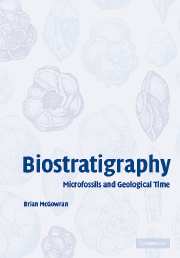Book contents
- Frontmatter
- Contents
- Preface
- Acknowledgments
- 1 Biogeohistory and the development of classical biostratigraphy
- 2 The biostratigraphy of fossil microplankton
- 3 Biostratigraphy: its integration into modern geochronology
- 4 Biostratigraphy and biohistorical theory I: evolution and correlation
- 5 Systemic stratigraphy: beyond classical biostratigraphy
- 6 Biostratigraphy and biohistorical theory II: carving Nature at the joints
- 7 Biostratigraphy and chronostratigraphic classification
- 8 On biostratigraphy and biogeohistory
- References
- Index
6 - Biostratigraphy and biohistorical theory II: carving Nature at the joints
Published online by Cambridge University Press: 02 December 2009
- Frontmatter
- Contents
- Preface
- Acknowledgments
- 1 Biogeohistory and the development of classical biostratigraphy
- 2 The biostratigraphy of fossil microplankton
- 3 Biostratigraphy: its integration into modern geochronology
- 4 Biostratigraphy and biohistorical theory I: evolution and correlation
- 5 Systemic stratigraphy: beyond classical biostratigraphy
- 6 Biostratigraphy and biohistorical theory II: carving Nature at the joints
- 7 Biostratigraphy and chronostratigraphic classification
- 8 On biostratigraphy and biogeohistory
- References
- Index
Summary
Summary
Geological timescales and phenomena in time series, biological classifications and assemblages as remnants of ancient ecologies – all of these constructions and reconstructions are hierarchical. There is a strong third-order parallel through time between depositional sequences and biozones based on speciations and extinctions. In the same window of 106 years there is also a rank in biofacies and community, i.e. the entities of ecostratigraphy. A ‘Palaeozoic’ notion of fossil assemblages coherently shifting in response to environmental shifts (e.g. sea-level changes) is not useful in Cenozoic biostratigraphy, where assemblage zones were abandoned long since. Although there are natural events in the sense of real ranges and real extinctions and speciations, there are not natural biostratigraphic units beyond that; integrated geochronology is splendidly opportunistic. Nature is carved at the joints more readily in phylogeny than in community. This is because the components of a phylogenetic tree are robust individuals tightly constructed, whereas communities are looser and less robust. Even so, there is a rhythm in biochronological resolution which can be related to rhythms in Earth history, perhaps responding more cogently to environmental notions such as the trophic resource continuum than to macroevolutionary notions such as the effect hypothesis.
Hierarchy, tiering and the scales of time and life
The genealogical hierarchy comprises genome, deme, species, and monophyletic taxon. It is stable, it supplies the players, and it records the differential results, namely the outcome of the game of life.
- Type
- Chapter
- Information
- BiostratigraphyMicrofossils and Geological Time, pp. 205 - 270Publisher: Cambridge University PressPrint publication year: 2005

